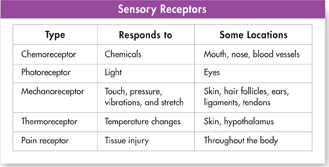31.3 The Peripheral Nervous System
 How does the central nervous system receive sensory information?
How does the central nervous system receive sensory information? How do muscles and glands receive commands from the central nervous system?
How do muscles and glands receive commands from the central nervous system?
somatic nervous system
reflex arc
autonomic nervous system
Flowchart As you read, make a flowchart that shows the flow of information between the divisions of the peripheral nervous system and the central nervous system.
THINK ABOUT IT It's all about input and output. No computer is worth much unless it can accept input from the world around it. And, no matter how quickly it calculates, no result is of any meaning unless there's a way to output it. The central nervous system faces the same issues. Can you guess what it uses for input and output devices?
The Sensory Division
 How does the central nervous system receive sensory information?
How does the central nervous system receive sensory information?
The peripheral nervous system consists of all the nerves and associated cells that are not part of the brain or spinal cord. Cranial nerves go through openings in the skull and stimulate regions of the head and neck. Spinal nerves stimulate the rest of the body. The cell bodies of cranial and spinal nerves are arranged in clusters called ganglia.
The peripheral nervous system, our link with the outside world, consists of two major divisions—the sensory division and the motor division.  The sensory division of the peripheral nervous system transmits impulses from sense organs to the central nervous system. The motor division transmits impulses from the central nervous system to the muscles and glands.
The sensory division of the peripheral nervous system transmits impulses from sense organs to the central nervous system. The motor division transmits impulses from the central nervous system to the muscles and glands.
Sensory receptors are cells that transmit information about changes in the environment—both internal and external. These changes are called stimuli. Sensory receptors can be categorized by the type of stimuli to which they respond. Figure 31–10 shows the functions and locations of several types of sensory receptors. When stimulated, sensory receptors transmit impulses to sensory neurons. Sensory neurons then transmit impulses to the central nervous system.

FIGURE 31–10 Sensory Receptors Sensory receptors react to a specific stimulus such as light or sound by sending impulses to sensory neurons. Apply Concepts List three types of sensory receptors that are activated when you walk into a busy flower shop.

Table of Contents
- Formulas and Equations
- Applying Formulas and Equations
- Mean, Median, and Mode
- Estimation
- Using Measurements in Calculations
- Effects of Measurement Errors
- Accuracy
- Precision
- Comparing Accuracy and Precision
- Significant Figures
- Calculating With Significant Figures
- Scientific Notation
- Calculating With Scientific Notation
- Dimensional Analysis
- Applying Dimensional Analysis





